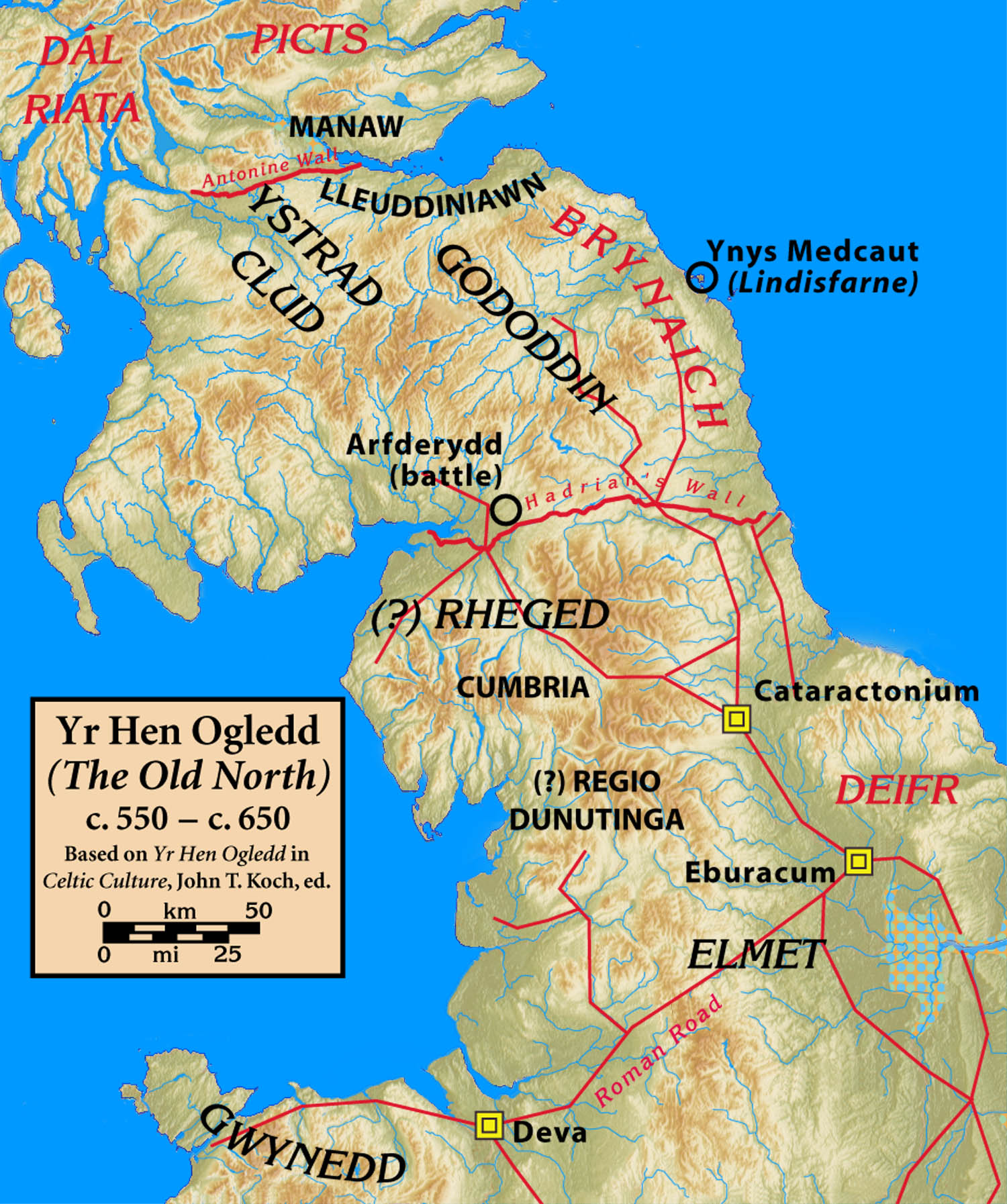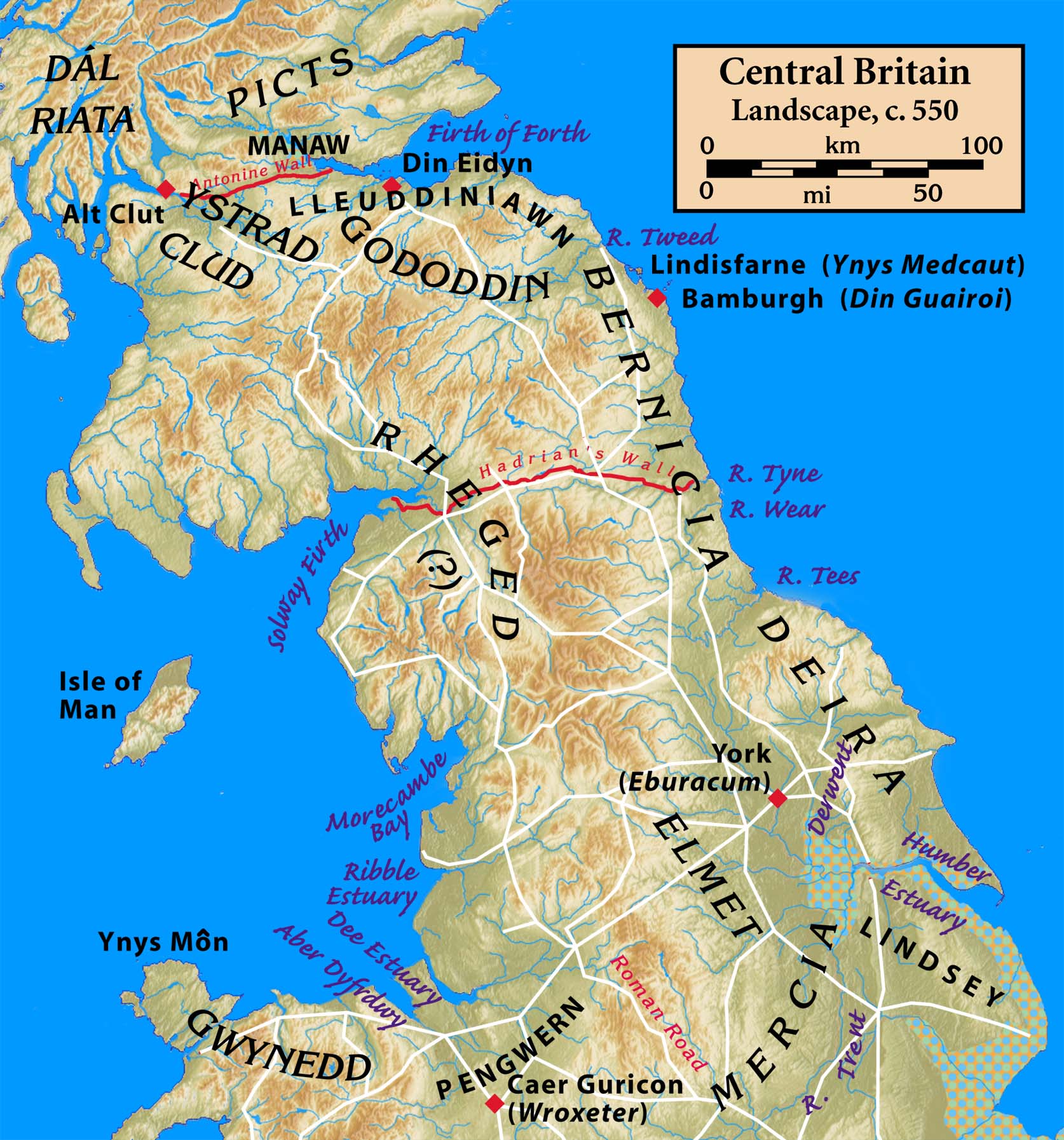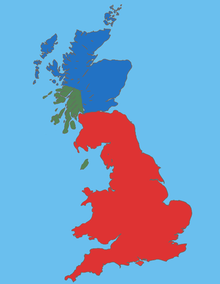|
Gododdin
The Gododdin () were a Brittonic people of north-eastern Britannia, the area known as the Hen Ogledd or Old North (modern south-east Scotland and north-east England), in the sub-Roman period. Descendants of the Votadini, they are best known as the subject of the 6th-century Welsh poem '' Y Gododdin'', which memorialises the Battle of Catraeth and is attributed to Aneirin. The name ''Gododdin'' is the Modern Welsh form, but the name appeared in Old Welsh as ''Guotodin'' and derived from the tribal name '' Votadini'' recorded in Classical sources, such as in Greek texts from the Roman period. Kingdom It is not known exactly how far the kingdom of the Gododdin extended, possibly from the Stirling area to the kingdom of '' Bryneich'' (Bernicia), and including what are now the Lothian and Borders regions of eastern Scotland. It was bounded to the west by the Brittonic Kingdom of Strathclyde, and to the north by the Picts. Those living around Clackmannanshire were known as ... [...More Info...] [...Related Items...] OR: [Wikipedia] [Google] [Baidu] |
Y Gododdin
''Y Gododdin'' () is a medieval Welsh poem consisting of a series of elegies to the men of the Brittonic kingdom of Gododdin and its allies who, according to the conventional interpretation, died fighting the Angles of Deira and Bernicia at a place named '' Catraeth'' in about AD 600. It is traditionally ascribed to the bard Aneirin and survives only in one manuscript, the " Book of Aneirin". The Book of Aneirin manuscript is from the later 13th century, but ''Y Gododdin'' has been dated to between the 7th and the early 11th centuries. The text is partly written in Middle Welsh orthography and partly in Old Welsh. The early date would place its oral composition soon after the battle, presumably in the ''Hen Ogledd'' ("Old North"); as such it would have originated in the Cumbric dialect of Common Brittonic.Elliott (2005), p. 583. Others consider it the work of a poet from Wales in the 9th, 10th, or 11th century. Even a 9th-century date would make it one of the oldest surv ... [...More Info...] [...Related Items...] OR: [Wikipedia] [Google] [Baidu] |
Manaw Gododdin
Manaw Gododdin was the narrow coastal region on the south side of the Firth of Forth, part of the Brythonic-speaking Kingdom of Gododdin in the post-Roman Era. It is notable as the homeland of Cunedda prior to his conquest of North Wales, and as the homeland of the heroic warriors in the literary epic '' Y Gododdin''. Pressed by the Picts expanding southward and the Northumbrians expanding northward, it was permanently destroyed in the 7th century and its territory absorbed into the then-ascendant Kingdom of Northumbria. The lands both south and north of the Firth of Forth were known as 'Manaw', but from the post-Roman Era forward, only the southern side is referred to as Manaw Gododdin, the Manaw associated with the people of Gododdin. Manaw Gododdin was adjacent to – and possibly included in – Eidyn, the region surrounding modern Edinburgh. Though Manaw Gododdin was located within the territory of modern Scotland, as a part of '' Yr Hen Ogledd'' (), it is also an intrin ... [...More Info...] [...Related Items...] OR: [Wikipedia] [Google] [Baidu] |
Din Eidyn
Eidyn was the region around modern Edinburgh in sub-Roman and early medieval Britain, approximately during the 5th–7th centuries. It centred on the stronghold of Din Eidyn, thought to have been at Castle Rock, now the site of Edinburgh Castle, and apparently included much of the area below the Firth of Forth. It was the most important district of the Brittonic kingdom of Gododdin, and a significant power in the Hen Ogledd, or Old North, the Brittonic-speaking area of what is now southern Scotland and northern England. The site of Din Eidyn has been nearly continuously occupied since the Bronze Age, serving as a stronghold of the Votadini during the Roman era and later the principal centre of their successors, the Gododdin kingdom. Eidyn's importance to the Hen Ogledd is reflected in the medieval poem ''Y Gododdin'', which concerns a war band that gathered there for a raid around AD 600. After years of decline, Eidyn was conquered by the Angles in 638. Eidyn is the source ... [...More Info...] [...Related Items...] OR: [Wikipedia] [Google] [Baidu] |
Hen Ogledd
Hen Ogledd (), meaning the Old North, is the historical region that was inhabited by the Celtic Britons, Brittonic people of sub-Roman Britain in the Early Middle Ages, now Northern England and the southern Scottish Lowlands, alongside the fellow Brittonic Celtic Elmet, Kingdom of Elmet, in Yorkshire. Its population spoke a variety of the Brittonic languages, Brittonic language known as Cumbric which is closely related to, if not a dialect of Old Welsh. The Welsh people, people of Wales and the Hen Ogledd considered themselves to be one people, and both were referred to as Cymry ('fellow-countrymen') from the Brittonic word ''combrogi''. The Hen Ogledd was distinct from the parts of Great Britain inhabited by the Picts, Anglo-Saxons, and Scoti. The major kingdoms of the Hen Ogledd were Elmet, Gododdin, Rheged, and the Kingdom of Strathclyde (Welsh: ''Ystrad Clud''). Smaller kingdoms included Aeron (kingdom), Aeron and Calchfynydd. Eidyn, Lothian, Lleuddiniawn, and Manaw Gododdin ... [...More Info...] [...Related Items...] OR: [Wikipedia] [Google] [Baidu] |
Battle Of Catraeth
The Battle of Catraeth was fought around AD 600 between a force raised by the Gododdin, a Brythonic people of the ''Hen Ogledd'' or "Old North" of Britain, and the Angles of Bernicia and Deira. It was evidently an assault by the Gododdin party on the Angle stronghold of Catraeth, perhaps Catterick, North Yorkshire. The Gododdin force was said to have consisted of warriors from all over the Hen Ogledd, and even some from as far afield as Gwynedd in North Wales and Pictland. The battle was disastrous for the Britons, who were nearly all killed. The slain warriors were commemorated in the important early poem ''Y Gododdin'', attributed to Aneirin. Battle In his ''Canu Aneirin'' Ifor Williams interpreted ''mynydawc mwynvawr'' in the text of ''Y Gododdin'' to refer to a person, Mynyddog Mwynfawr in modern Welsh. Mynyddog, in Williams' reading, was the king of the Gododdin, with his chief seat at Din Eidyn (modern Edinburgh). Around the year 600 Mynyddog gathered about 300 ... [...More Info...] [...Related Items...] OR: [Wikipedia] [Google] [Baidu] |
Aneirin
Aneirin (), also rendered as Aneurin or Neirin and Aneurin Gwawdrydd, was an early Medieval Brythonic war poet who lived during the 6th century. He is believed to have been a bard or court poet in one of the Cumbric kingdoms of the Hen Ogledd, probably that of Gododdin at Edinburgh, in modern Scotland. From the 17th century, he was usually known as Aneurin. Life Some records indicate that Aneirin was the son of Caunus (or Caw) and brother to Gildas. According to this version of his life, he was born at Dumbarton on the River Clyde. However, some scholars debate this parentage, and contend that these records are of later invention and are erroneous. Whoever his father was, Aneirin's mother, Dwywei is mentioned in '' Y Gododdin''. She may be the same lady who, according to Old Welsh pedigrees, married King Dunod who is generally thought to have ruled in the West Riding of Yorkshire. He may also be kin to another Brythonic poet, Cian Gwenith Gwawd. Aneirin's patrons were the no ... [...More Info...] [...Related Items...] OR: [Wikipedia] [Google] [Baidu] |
Votadini
The Votadini, also known as the ''Uotadini'', ''Wotādīni'', ''Votādīni'', or ''Otadini'' were a Celtic Britons, Brittonic people of the British Iron Age, Iron Age in Great Britain. Their territory was in what is now south-east Scotland and north-east England, extending from the Firth of Forth and around modern Stirling to the River Tyne, including at its peak what are now the Falkirk, Lothian and Scottish Borders, Borders regions and Northumberland. This area was briefly part of the Roman province of ''Roman Britain, Britannia''. The earliest known capital of the Votadini appears to have been the Traprain Law hill fort in East Lothian, until that was abandoned in the early 5th century. They afterwards moved to Din Eidyn (Edinburgh). The name is recorded as ''Votadini'' in classical sources, and as ''Otodini'' on old maps of ancient Roman Britain. Their descendants were the early medieval kingdom known in Old Welsh as ''Gododdin, Guotodin'', and in later Welsh as ''Gododdin'' ... [...More Info...] [...Related Items...] OR: [Wikipedia] [Google] [Baidu] |
Bernicia
Bernicia () was an Anglo-Saxon kingdom established by Anglian settlers of the 6th century in what is now southeastern Scotland and North East England. The Anglian territory of Bernicia was approximately equivalent to the modern English counties of Northumberland, Tyne and Wear, and Durham, as well as the Scottish counties of Berwickshire and East Lothian, stretching from the Forth to the Tees. In the early 7th century, it merged with its southern neighbour, Deira, to form the kingdom of Northumbria, and its borders subsequently expanded considerably. Etymologies Bernicia occurs in Old Welsh poetry as ''Bryneich'' or ''Byrneich'' and in the 9th-century '' Historia Brittonum'', (§ 61) as ''Berneich'', ''Birneich'', ''Bernech'' and ''Birnech''. Academics agree the name was originally Celtic. This name was then adopted by the Anglian settlers who rendered it in Old English as ''Bernice'' (Northumbrian dialect) or ''Beornice'' (West Saxon dialect). The counter hypothesis ... [...More Info...] [...Related Items...] OR: [Wikipedia] [Google] [Baidu] |
Kingdom Of Strathclyde
Strathclyde (, "valley of the River Clyde, Clyde"), also known as Cumbria, was a Celtic Britons, Brittonic kingdom in northern Britain during the Scotland in the Middle Ages, Middle Ages. It comprised parts of what is now southern Scotland and North West England, a region the Welsh tribes referred to as ''Yr Hen Ogledd'' (“the Old North"). At its greatest extent in the 10th century, it stretched from Loch Lomond to the River Eamont at Penrith, Cumbria, Penrith. Strathclyde seems to have been annexed by the Goidelic languages, Goidelic-speaking Kingdom of Alba in the 11th century, becoming part of the emerging Kingdom of Scotland. In its early days it was called the kingdom of ''Alt Clud'', the Brittonic name of its capital, and it controlled the region around Dumbarton Rock. This kingdom emerged during Britain's Sub-Roman Britain, post-Roman period and may have been founded by the Damnonii people. After the Siege of Dumbarton, sack of Dumbarton by a Viking army from Kingdom ... [...More Info...] [...Related Items...] OR: [Wikipedia] [Google] [Baidu] |
Edinburgh
Edinburgh is the capital city of Scotland and one of its 32 Council areas of Scotland, council areas. The city is located in southeast Scotland and is bounded to the north by the Firth of Forth and to the south by the Pentland Hills. Edinburgh had a population of in , making it the List of towns and cities in Scotland by population, second-most populous city in Scotland and the List of cities in the United Kingdom, seventh-most populous in the United Kingdom. The Functional urban area, wider metropolitan area had a population of 912,490 in the same year. Recognised as the capital of Scotland since at least the 15th century, Edinburgh is the seat of the Scottish Government, the Scottish Parliament, the Courts of Scotland, highest courts in Scotland, and the Palace of Holyroodhouse, the official residence of the Monarchy of the United Kingdom, British monarch in Scotland. It is also the annual venue of the General Assembly of the Church of Scotland. The city has long been a cent ... [...More Info...] [...Related Items...] OR: [Wikipedia] [Google] [Baidu] |
Sub-Roman Britain
Sub-Roman Britain, also called post-Roman Britain or Dark Age Britain, is the period of late antiquity in Great Britain between the end of Roman rule and the founding of Anglo-Saxon kingdoms. The term was originally used to describe archaeological remains found in 5th- and 6th-century AD sites that hinted at the decay of locally made wares from a previous higher standard under the Roman Empire. It is now used to describe the period that began with the recall of Roman troops from Britannia to Gaul by Constantine III in 407 and ended with the Battle of Deorham in 577. This period has attracted a great deal of academic and popular debate, in part because of the lack of written records from the time. Meaning of terms The period of sub-Roman Britain traditionally covers the history of the parts of Britain that had been under Roman rule from the end of Roman imperial rule, traditionally dated to be in 410, to the arrival of Saint Augustine in 597. The date taken for the end ... [...More Info...] [...Related Items...] OR: [Wikipedia] [Google] [Baidu] |
Britons (historical)
The Britons (Linguistic reconstruction, *''Pritanī'', , ), also known as Celtic Britons or Ancient Britons, were the Celts, Celtic people who inhabited Great Britain from at least the British Iron Age until the High Middle Ages, at which point they diverged into the Welsh people, Welsh, Cornish people, Cornish, and Bretons (among others). They spoke Common Brittonic, the ancestor of the modern Brittonic languages. The earliest written evidence for the Britons is from Greco-Roman world, Greco-Roman writers and dates to the Iron Age. Ancient Britain was made up of many tribes and kingdoms, associated with various Hillforts in Britain, hillforts. The Britons followed an ancient Celtic religion overseen by druids. Some of the southern tribes had strong links with mainland Europe, especially Gaul and Gallia Belgica, Belgica, and Celtic currency of Britain, minted their own coins. The Roman Empire Roman conquest of Britain, conquered most of Britain in the 1st century AD, creating th ... [...More Info...] [...Related Items...] OR: [Wikipedia] [Google] [Baidu] |







